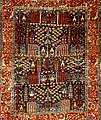Azerbaijani carpet

The Azerbaijani carpet is an important part of Azerbaijani ( Azerbaijan and South Azerbaijan ) arts and culture. It has been mentioned in various places since ancient times and has also been known in Europe since the Renaissance .
Early references
First mentions can be found in ancient authors such as Xenophon , as well as in historical chronicles and travelogues of Arab scholars such as At-Tabarī and Al-Muqaddasi . He is also described in poetic works by Nisami , Chaqani and shown in pictures from the Renaissance period, for example by Hans Holbein , Hans Memling and Carlo Crivelli .
Differences in carpets
According to their artistic and technical characteristics, Azerbaijani carpets are divided into four different groups, which correspond to the four regions in which they are made:
Schirwan carpet
The Schirwan carpets are hand-woven and come from the Shirvan region in the southeastern Caucasus . In contrast to the rather small carpets from Baku , those from the southern part of the area around the city of Salyan are long and narrow, so they have the shape of the runner . Small prayer rugs , including the widespread models with the so-called buta ornament (leaf outlines) on a blue background, are made in the city of Marasa. They are usually made of wool , but there are also some with a cotton border .
Schemacha carpet , 1937
Quba carpet
The Quba carpets come from the area around the city of Quba , which is located in the Caucasus in northern Azerbaijan. They have been woven in different villages since the middle of the 19th century. These carpets are considered difficult to make because of their geometric floral patterns on a blue or cream background. The carpets from Gonagkend village have a large medallion in the middle, while the carpets from Karagashli have Persian elements in the carpet script (ornamental plant tendrils and crabs). The widespread so-called Caucasian red field carpet , made in Soumach weaving technique, comes from the city of Qusar . Historical Caucasian carpets from the 17th and 18th centuries often show dragons, Persian geometric patterns and sometimes reach lengths of up to six meters.
Examples of carpets from Karabakh
Tabrish carpets
Gasach carpet
Gasach carpets are woven by the rural population in western Azerbaijan. But they are also produced in northern Armenia and the adjoining southern part of Georgia . The Gasach carpets are mainly made of wool and have symmetrically layered shiny knots. The predominant colors are red, blue and ivory with simple patterns and up to three medallions or central squares. The carpets are rarely larger than two meters, there are also small prayer carpets here.
Goose carpet
These carpets have simple angular patterns and rich colors. Often they have octagonal patterns, stars and three geometric medallions along the longitudinal axis. Typical colors are blue, dark blue and red tones. Older carpets are made entirely of wool, newer examples had layered cotton knots.
Individual evidence
- ↑ a b L. S. Bretanizkiy, BW Weimarn: Azerbaijani art. ( Memento of February 15, 2010 in the Internet Archive ) Moscow, 1976, pp. 116–120. (Russian).
- ^ Britannica Encyclopedia. Shirvan-rugs. (English)
- ↑ Cuba carpet. In: Britannica Encyclopedia. (English).
- ↑ Alastair Hull, Jose Luczyc-Wyhowska: Kilim. The Complete Guide. New edition Thames & Hudson, London 2005, ISBN 978-0-500-28221-2 , p. 240.
- ↑ Kazakh rugs. In: Britannica Encyclopedia.
- ↑ Genje carpet. In: Britannica Encyclopedia.
literature
- Alastair Hull, Jose Luczyc-Wyhowska: Kilim. The Complete Guide. New edition Thames & Hudson, London 2005, ISBN 978-0-500-28221-2 .
- Vidadi Muradov: Azerbaijan Carpets. Baku 2008.
- Werner Zollinger u. a .: Azerbaijani-Caucasian carpets. Ulmke collection from Switzerland. Offizin Hartung, Hamburg 2001, ISBN 3-925813-09-8 .


































